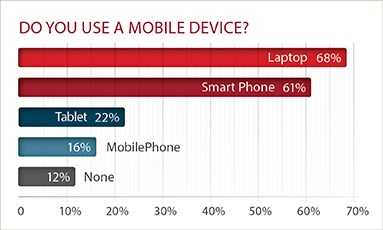Gardner’s Media Usage in Manufacturing 2014 – Part 5
Customer Seek Answers…But How? Insights: Mobile Media Starts to Come of Age
It’s said knowledge is power . . . never truer than in the “Information Age.” This is part 5 of a 6 part series of articles, discussing the findings of Gardner Business Media’s research study, Media Usage in Manufacturing 2014 and what they might mean to the B2B marketer.
Mobile Media is Beginning to Affect the Buying Process
Insights: There’s Dichotomy in How Business Buyers Define “Mobile” . . . But the Definition Is Changing
By Mark Semmelmayer
Chief Idea Officer
Pen & Inc. Marketing Communications

This is part 4 of a 6 part series, discussing Gardner Business Media’s research study, Media Usage in Manufacturing 2014. The series breaks down study findings, and their implications for the B2B marketer. Download the report here.
In this post, we’ll explore an incremental shift in buyer behavior. The survey reveals an interesting insight on what the manufacturing buyer defines as “mobile” media and the impact on their thinking, giving an indication that “true” mobile might be beginning to have an impact.
Sure, I have a laptop . . .
I’ll go back to a theorem I’ve held as a basis for much of this series. There’s a “generation gap” in business buying. The baby-boomer “old guard’ is still in charge, but the young Turks are coming on.
The survey’s overview of mobile usage, I think, really demonstrates this. When asked “Do you use a mobile device?,” the results are revealing.
Laptop: 68%
Smart Phone: 61%
Tablet: 22%
Mobile Phone: 16%
None: 12%

Let’s be clear. While they are, arguably, mobile devices, I don’t think anybody in today’s B2B marketing game really thinks of laptops as mobile platforms. Tablets are a bit of a different animal, a hybrid that is beginning to extend its impact. But, it’s the smart phone that truly qualifies…and there’s no real quantification in the study to tell us how the respondents differentiated smart phones from mobile phones. If you lump them together, their usage percentage is higher than laptops.
To amplify this thinking, one only needs to review the October, 2014 State of B2B Procurement study from Acquity Group, part of Accenture Interactive. It’s pretty…no, very…informative. I encourage you to review it. For the purposes of this post, though, here’s what they found with regard to the increasing role of mobile device usage among business buyers:
- 44% have conducted research on an item using a mobile device
- 55% of B2B buyers aged 18-25 (Millennials) use mobile phones to research purchases, as do 36% of respondents aged over 45
- 24% have made a business purchase using a mobile device (35% of Millennials; 19% among those aged over 45)
- 37% use tablets for research (half of Millennials; 31% aged over 45)
- 25% have made a business purchase using a tablet
Revealing. Also supportive of the idea of a “generation gap.” And, as one of the poets of the boomer generation put it, “the times they are a’changin’.”
. . . and as a B2B marketer, I have time to adapt.
Emphatically, no! In the previous installment in this series, we discussed the increasing importance of search engines, especially Google, as a growing primary source of information for the B2B buyer. In that post, we cited a post by Paul Bruemmer, “The Importance of Search Engine Optimization/Search Engine Marketing for B2B Marketers.” The Acquity Groups study (cited above), takes the importance of search engine use a step further.
“While supplier websites are the most common channel used to research purchases, by 83.4% of survey respondents, a strong majority also use Google search (77%). Other research channels include user reviews of products (41.8%) and 3rd party websites (34%), though fewer use blogs (10.8%) and social media (8.6%). In a sobering result for vendors, just 37% of B2B buyers who use supplier websites to conduct research say that this is their most helpful channel.”
One set of study results is directional . . . two is a trend. The importance of a Google search cannot be understated. So, here’s the million dollar question. How many of you know that Google made a major change in its search result algorithms on April 21? Here’s Google’s statement on the move they made to begin favoring websites that are mobile-enabled in search results:
“As we noted earlier this year, today’s the day we begin globally rolling out our mobile-friendly update. We’re boosting the ranking of mobile-friendly pages on mobile search results. Now searchers can more easily find high-quality and relevant results where text is readable without tapping or zooming, tap targets are spaced appropriately, and the page avoids unplayable content or horizontal scrolling.”
Get it now? While Google doesn’t say it in so many words, unless your website and content are mobile-friendly, your chances of showing up high in search results will be penalized. Google, a prime mover in the online world, has just cast their vote on what the online world is going to be. As marketers, we need to pay attention. Get mobile or go home.

Practical Implications: Your Mobile Marketing Strategy Needs an Upgrade
1. Your search strategy and its maintenance is a fundamental job of your digital team. They now need to understand the implications of assuring your web presence is mobile-friendly. At the same time, as marketing begins its transition from a Boomer target to a Millennial target, digital strategy must, for the time being, dovetail with more traditional approaches, in an integrated marketing communications strategy, including traditional “Push” media.
2. Search engine marketing efforts are “Pull” media. With “Pull” media, the buyer’s in charge of the information exchange. That means, wherever your buyer goes to get information, you need to show up. Google’s mobile-friendly dictum changes that game. Go mobile or else. Make sure you work with it.
3. Another critical role for your digital team is content marketing. Manufacturing buyers trust expert technical content when forming purchasing decisions. With Google’s nod to mobile enablement, review your online content, on your site or on industry sites, where you may have White Papers or other information, to make sure the content works with mobile devices.
Need more information?
Mark Semmelmayer
Chief Idea Officer
Pen & Inc. Marketing Communications
Marietta, GA
770-354-4737
LinkedIn


